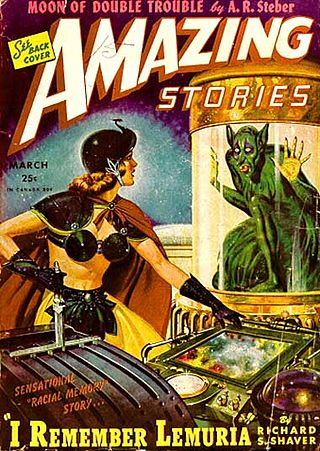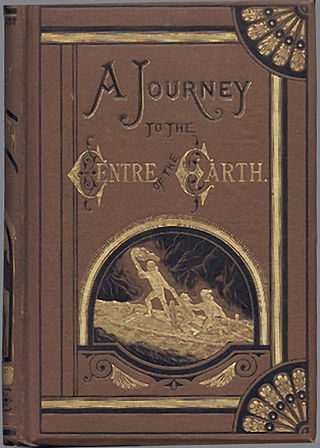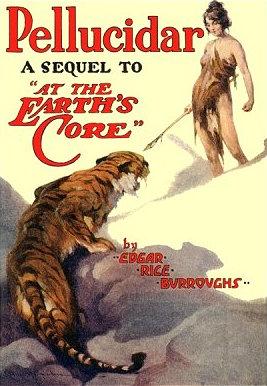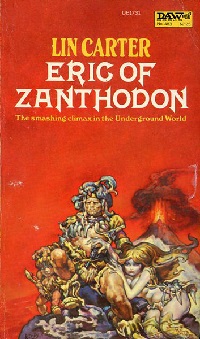
The Hollow Earth is a concept proposing that the planet Earth is entirely hollow or contains a substantial interior space. Notably suggested by Edmond Halley in the late 17th century, the notion was disproven, first tentatively by Pierre Bouguer in 1740, then definitively by Charles Hutton in his Schiehallion experiment around 1774.

Pellucidar is a fictional Hollow Earth invented by American writer Edgar Rice Burroughs for a series of action adventure stories. In a crossover event, Tarzan, who was also created by Burroughs, visits Pellucidar.

Apocalyptic and post-apocalyptic fiction is a subgenre of science fiction in which the Earth's civilization is collapsing or has collapsed. The apocalypse event may be climatic, such as runaway climate change; astronomical, such as an impact event; destructive, such as nuclear holocaust or resource depletion; medical, such as a pandemic, whether natural or human-caused; end time, such as the Last Judgment, Second Coming or Ragnarök; or any other scenario in which the outcome is apocalyptic, such as a zombie apocalypse, cybernetic revolt, technological singularity, dysgenics or alien invasion.

A subterranean river is a river or watercourse that runs wholly or partly beneath the ground, one where the riverbed does not represent the surface of the Earth. It is distinct from an aquifer, which may flow like a river but is contained within a permeable layer of rock or other unconsolidated materials. A river flowing below ground level in an open gorge is not classed as subterranean.

Richard Sharpe Shaver was an American writer and artist who achieved notoriety in the years following World War II as the author of controversial stories that were printed in science fiction magazines. In Shaver's story, he claimed that he had had personal experience of a sinister ancient civilization that harbored fantastic technology in caverns under the earth. The controversy stemmed from the claim by Shaver, and his editor and publisher Ray Palmer, that Shaver's writings, while presented in the guise of fiction, were fundamentally true. Shaver's stories were promoted by Ray Palmer as "The Shaver Mystery".
The Underdark is a fictional setting which has appeared in Dungeons & Dragons role-playing campaigns and Dungeons & Dragons-based fiction books, including the Legend of Drizzt series by R. A. Salvatore. It is described as a vast subterranean network of interconnected caverns and tunnels, stretching beneath entire continents and forming an underworld for surface settings. Polygon called it "one of D&D's most well-known realms".

Journey to the Center of the Earth, also translated with the variant titles A Journey to the Centre of the Earth and A Journey into the Interior of the Earth, is a classic science fiction novel by Jules Verne. It was first published in French in 1864, then reissued in 1867 in a revised and expanded edition. Professor Otto Lidenbrock is the tale's central figure, an eccentric German scientist who believes there are volcanic tubes that reach to the very center of the earth. He, his nephew Axel, and their Icelandic guide Hans rappel into Iceland's celebrated inactive volcano Snæfellsjökull, then contend with many dangers, including cave-ins, subpolar tornadoes, an underground ocean, and living prehistoric creatures from the Mesozoic and Cenozoic eras. Eventually the three explorers are spewed back to the surface by an active volcano, Stromboli, located in southern Italy.
The lost world is a subgenre of the fantasy or science fiction genres that involves the discovery of an unknown Earth civilization. It began as a subgenre of the late-Victorian adventure romance and remains popular into the 21st century.

The Secret People (1935) is a science fiction novel by English writer John Wyndham. It is set in 1964, and features a British couple who find themselves held captive by an ancient race of pygmies dwelling beneath the Sahara desert. The novel was written under Wyndham's early pen name, John Beynon.
This is a list of occurrences of space elevators in fiction. Some depictions were made before the space elevator concept became fully established.

Etidorhpa, or, the end of the earth: the strange history of a mysterious being and the account of a remarkable journey is the title of a scientific allegory or science fiction novel by John Uri Lloyd, a pharmacognocist and pharmaceutical manufacturer of Cincinnati, Ohio. Etidorhpa was published in 1895.

At the Earth's Core is a 1914 fantasy novel by American writer Edgar Rice Burroughs, the first in his series about the fictional "hollow earth" land of Pellucidar. It first appeared as a four-part serial in All-Story Weekly from April 4 to 25, 1914. It was first published in book form in hardcover by A. C. McClurg in July, 1922.

Travelling to the Earth's center is a popular theme in science fiction. Some subterranean fiction involves traveling to the Earth's center and finding either a Hollow Earth or Earth's molten core. Planetary scientist David J. Stevenson suggested sending a probe to the core as a thought experiment. Humans have drilled over 12 kilometers in the Sakhalin-I. In terms of depth below the surface, the Kola Superdeep Borehole SG-3 retains the world record at 12,262 metres (40,230 ft) in 1989 and still is the deepest artificial point on Earth.

David Innes is a fictional character created by Edgar Rice Burroughs as the protagonist of his Pellucidar novels. He first appeared in the novel At the Earth's Core, serialized in four parts in All-Story Weekly from April 4–25, 1914 and issued in book form in hardcover by A. C. McClurg in July, 1922.

Pellucidar is a 1915 fantasy novel by American writer Edgar Rice Burroughs, the second in his series about the fictional "Hollow Earth" land of Pellucidar. It first appeared as a five-part serial in All-Story Weekly from May 1 to 29, 1915. It was first published in book form in hardcover by A. C. McClurg in September, 1923. A map by Burroughs of the Empire of Pellucidar accompanied both the magazine and book versions.

Journey to the Underground World is a science fiction novel by American writer Lin Carter, the first in his series about the fictional "Hollow Earth" land of Zanthodon. It was first published in paperback by DAW Books in November 1979, with an ebook edition following from Gateway/Orion in August 2018. It was also gathered together with the other volumes in the series into the omnibus ebook collection The Zanthodon Megapack.

Zanthodon is a science fiction novel by American writer Lin Carter, the second in his series about the fictional "Hollow Earth" land of Zanthodon. It was first published in paperback by DAW Books in June 1980, with an ebook edition following from Gateway/Orion in October 2018. It was also gathered together with the other volumes in the series into the omnibus ebook collection The Zanthodon Megapack.

Hurok of the Stone Age is a science fiction novel by American writer Lin Carter, the third in his series about the fictional "Hollow Earth" land of Zanthodon. It was first published in paperback by DAW Books in February 1981, with an ebook edition following from Gateway/Orion in October 2018. It was also gathered together with the other volumes in the series into the omnibus ebook collection The Zanthodon Megapack.

Eric of Zanthodon is a science fiction novel by American writer Lin Carter, the fifth and last in his series about the fictional "Hollow Earth" land of Zanthodon. It was first published in paperback by DAW Books in May 1982, with an ebook edition following from Gateway/Orion in October 2018. It was also gathered together with the other volumes in the series into the omnibus ebook collection The Zanthodon Megapack.
















